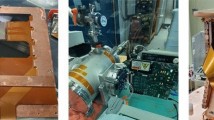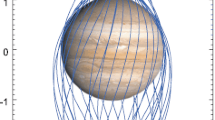Abstract
Precise measurements of polarization patterns in cosmic microwave background (CMB) provide deep knowledge about the begin of the Universe. The GroundBIRD experiment aims to measure the CMB polarization by using microwave kinetic inductance detector (MKID) arrays. The MKID is suited to multiplexing. One of our requirements is a MUX factor (the number of readout channels for a single wire pair) of at least 100. If we make frequency combs of the MKIDs with 2-MHz spacing, a bandwidth of 200 MHz satisfies 100 MUX. The analog electronics must consist of an analog-to-digital converter (ADC), digital-to-analog converter (DAC), and local oscillator. We developed our own analog electronics board “RHEA.” Two outputs/inputs of DAC/ADC with a 200-MHz clock provide an effective bandwidth of 200 MHz. The RHEA allows us to measure both the amplitude and phase responses of each MKID simultaneously. These data are continuously sampled at a high rate (e.g., 1 kSPS) and with no dead time. We achieved 12 and 14 bits resolution for ADC and DAC, respectively. This corresponds to achieve that our electronics achieved low noise: 1/1000 compared with the detector noise. We also achieved low power consumption compared with that of other electronics development for other experiments. Another important feature is that the board is completely separated from the digital part. Each user can choose their preferred field-programmable array. With the combination of the Kintex-7 evaluation kit from Xilinx, we demonstrated readout of MKID response.






Similar content being viewed by others
References
P.K. Day, H.G. LeDuc, B.A. Mazin, A. Vayonakis, J. Zmuidzinas, Nature 425, 817–821 (2003)
S. Oguri et al., J. Low Temp. Phys. 176, 691–697 (2014)
O. Bourrion, A. Bideaud, A. Benoit, A. Cruciani, J.F. Macias-Perez, A. Monfardini, M. Roesch, L. Swenson, C. Vescovi, JINST 6, P06012 (2011)
S.J.C. Yates, A.M. Baryshev, J.J.A. Baselmans, B. Klein, R. Guesten, APL 95(4), 042504 (2009)
K. Karatsu, S. Mima, S. Oguri et al., IEICE Trans. Electron. E98–C(3), 207 (2015)
Acknowledgments
This work is supported by Grants-in-Aid for Scientific Research from The Ministry of Education, Culture, Sports, Science, and Technology, Japan (KAKENHI 26247045 and 15H05743). We also acknowledge support from the Open Source Consortium of Instrumentation (Open-It).
Author information
Authors and Affiliations
Corresponding author
Rights and permissions
About this article
Cite this article
Ishitsuka, H., Ikeno, M., Oguri, S. et al. Front–End Electronics for the Array Readout of a Microwave Kinetic Inductance Detector Towards Observation of Cosmic Microwave Background Polarization. J Low Temp Phys 184, 424–430 (2016). https://doi.org/10.1007/s10909-015-1467-7
Received:
Accepted:
Published:
Issue Date:
DOI: https://doi.org/10.1007/s10909-015-1467-7




